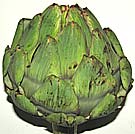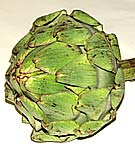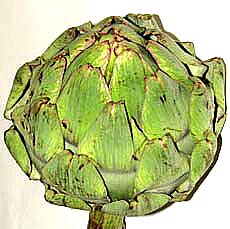Globe Artichoke - how to cultivate from offsets
GLOBE ARTICHOKE PROBLEMS
If the artichoke crop is small and the stems are hard and woody with flower heads that are dry and worthless, then poor, dry soil conditions are to blame.
If the artichokes are properly cultivated this should not occur.
Very wet conditions may cause the crowns of the artichokes to rot - make sure the beds are well drained.
Slugs may be attracted to the young artichoke plants.

RECOMMENDED VARIETIES
Gros Vert de Laon
Bayramapsha
Green Globe
Purple Globe
Gros Camus de Bretagne
Romanesco
Violet de Provence

HISTORY
Artichokes were first cultivated in Sicily in Greek times - they were known as Kaktos.
In this Greek period the cultivated flowerheads and leaves, which had been improved from the wild form of the plant, were eaten.
The Romans obtained the artichoke plant from the Greeks, and referred to it as carduus, the wild form of artichoke is still known as a cardoon .
VEGETABLE PAGES
SOCIETIES
GARDEN TIP
Artichokes are very decorative and can be grown in herbaceous borders to provide interesting flowers and foliage
GLOBE ARTICHOKE
 The
Globe Artichoke (Cynara cardunculus) is a perennial plant
with a thistle-like head that has fleshy scale like leaves, surrounding
the heart.
The
Globe Artichoke (Cynara cardunculus) is a perennial plant
with a thistle-like head that has fleshy scale like leaves, surrounding
the heart.
It is this head, that has a distinct flavour, which is edible..The base of each leaf can be eaten, but the heart has the most flavour.
The flower bearing stems will grow to about 1.5 metres (5 feet) and should be sheltered from winds.
The best way to grow artichokes is from offsets - raising globe artichokes from seed is not advisable because is not advisable because there is to much variation in size and flavour.
WHERE TO GROW GLOBE ARTICHOKES
Globe artichokes need to be grown on well drained soil that t is kept moist in the summer and dry in the winter - Artichoke plants grown in a sunny position will have more flavour if grown in direct sunlight.
Globe artichokes will need a permanent bed outside the rotation system. And it is best to replace them every three years, as the older plants will generally produce only a few small flowers.
Before planting, dig in well-rotted manure or garden compost.
Plant out in April for a crop in August or September.
Cut the flowers on two or three year old plants in July.

PLANTING OFFSETS
A reliable method of growing globe artichokes is by planting offsets. The only way to reproduce an existing variety is by this method.
Offsets can be taken from established plants or bought from the nursery.oving old established plants you can increase the stock by severing the side growths which develop from the base of the plant each year. Pick strong shoots and cut them off when they are 22.5cm (9in) long.
Make sure that you cut vertically so as to keep a piece of the old root- stock at the base. Cut off the top quarter of the leaves and plant in their permanent bed in the second or third week of April.
Plant these globe artichoke suckers in rows 90 cm (3ft) apart, and allowing 90 cm (3ft) between the plants - The soil should be the same level as the old plant.
Make holes and place the completMake holes and place the complete root and 2.5 cm (1in) of the sucker itself and firm well. If the ground is dry, give a good watering. Keep the ground moist in dry weather to establish them.
CARE OF GLOBE ARTICHOKES
By late May or early June the artichokes should be growing sturdily. If they are not doing well by then you should top dress with a complete fertilizer or dried blood at the start of May.
Keep the bed free of weeds by regularly hoeing in between the plants and to create a dust mulch( 12mm ) layer of loose soil over the surface of the ground.wn to about 30 to 37.5cm (12 to 15 in) in November when the leaves turn yellow and earth them up leaving 5 or 7.5 (2 or 3 in) of stem above the soil. Then pack round with straw or bracken 30cm (12in ) deep over the soil but not covering the stems.
Only in severe weather should you cover right over the plants , but remove it as soon as the cold spell has gone.
Globe artichokes should be allowed to give three crops, and after the crop has been gathered in the third year the plants should be destroyed.
If planted in spring the young plants will produce heads in late summer.
In their second and third years, heads will be produced in June and July.
In April second and third year Artichoke plants should have their shoots reduced to three.
Scrape the soil away and sever with a sharp knife the surplus shoots near ground level.
Some may be planted to form a new row.
This means that the globe artichoke This means that the globe artichoke has a three year crop rotation.
HARVESTING GLOBE ARTICHOKES
There are no large flower heads produced in the first year.
Harvest in August or September for new plants, or in July for older plants. Globe Artichokes grow a large thistle-like head at the ends of the stems and a number of smaller heads on lateral shoots.
Allow only four to six heads to develop on each new plant and remove unwanted buds from lateral shoots.
Harvest the artichoke flower heads when they have reached a good size and before they open. They should be green and tight with fleshy outer scales. Once the flower heads start to turn purple and scales start to open they become inedible.
Cut off the main head known as the King head at the end of each stem first.
Cut the stem halfway back at the same time. Secondary growths will then develop, each of which will produce another tender flower head about the size of a cricket ball.
Globe artichokes are best cut one hour before cooking.
FIND USEFUL ADVICE AND HELP ON GARDEN GROWER
|
Organic Gardening Methods | Topsoil Suppliers West Sussex | Grow Lavender | Hot Tubs Kent | Surrey Topsoil Suppliers | Tree Surgeons Kent | Autumn Crocus | Lily Beetle | Grow Millet Seed | Clay Soils |